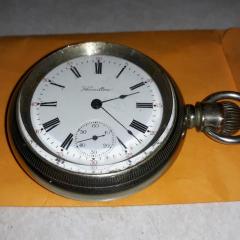Broken pivot
-
Similar Content
-
Recently Browsing
- No registered users viewing this page.
-
Topics
-
Posts
-
By Neverenoughwatches · Posted
I often think about painting clear varnish on the coil. -
By HectorLooi · Posted
I hate this battery release design in Ronda movements. It's an accident waiting to happen. One slip and the coil is gone. I wonder if it's a deliberate design. -
so let's break this down the words restaffed balance wheel correctly would mean no distortion at all on the balance wheel. Which can be done but often isn't. Oftentimes balance wheels end up and times particularly discussing a bimetallic all bent up like the one in this discussion. If the balance wheel is out of round you definitely get a poise issue. You also get an issue if somebody pleases and out around balance wheel and then you fix the out of round now the wheel is poised incorrectly because somebody didn't physically make sure the balance wheel was correct in the first place. Yes people really do poise balance wheels that are neither flat or round it's quite annoying and then it typically with anything vintage there's an extreme likelihood of timing issues. Like the fun I had yesterday the wall thumb was 400 seconds fast and had a 202nd positional problem. So yes it's extremely common on vintage watches you're going to have things to fix from prior inappropriate repairs typically and it depends upon how it nitpicky you want to be here. In other words if you are statically poising the definition of poised would be if you give the balance wheel of push it will rotate eventually come to a stop and it will not rock back and forth at all is considered perfectly poised. Typically when I poise I don't worry about that I will let it rock back and forth because it still going to be within 15 seconds typically. Now the problem with statically poising absolutely perfectly is that it does not take into account the hairspring. This is why ideally if you are really obsessed you statically poise until your close and then finish with dynamic poising. This will take into account the hairspring collet that's probably not a poised collet. Yes Hamilton had another companies had poised collet's they hairspring itself affects the poise so for absolute perfect you have to dynamic poise. So the suggestion has been that it absolutely poised dynamically done balance wheel will not be statically poise absolutely perfectly. this is an interesting one? In the United States of America over a time span and I don't remember the exact but it ended in the 60s there was a tear off on watches to protect the American watch industry. I've read the books on the tariffs specifications it would bump up the cost of better watches to making them expensive. This is why you will often see a nice Omega watch for instance that was regulated was adjusted and was still keeping really good time will be marked not adjusted. Because the quantity of jewels each jewel bumped up the cost adjustment adjustment and variety of positions bumped up the cost so a huge percentage of watches imported into this country will be not adjusted but they were adjusted at the factory it's just a terra thing then I suspect that even the cheapest of watches probably were somewhat adjusted because if they had zero adjustments I have no idea how bad the timekeeping would be? It's one of the problems of we don't actually have numbers of what the watches really should be doing we only have numbers of timekeeping basically when timing machines exist or for things like railroad grade watches where they absolutely had to know what the timekeeping is doing. So railroad timekeeping specification in this country is of watch Dependent up has to be within plus or -30/2 per week. Which if you compare it to the specifications of chronometer grade will ask which I think could be up to six seconds a day is better than a Rolex. this is one of my amusements at work. There we have that really nice which he timing machine full automatic microphone we look at every single watch and six positions and my boss once the watches all the keep really good time. So basically the watchmakers have learned to let the boss adjust the watches it seems to make him happy and we can do other things like service watches. So yesterday's fun on the 18 size Waltham to get the 400 timing down to think he got it down to 15 seconds it might've been better than that the Delta was still might've been within a minute much better than what it was before but still took more than an hour of time. When we don't specifically charge for this we charge for servicing of the watch we do not typically charge to make your watch keep time in multiple positions so yes it wastes a lot of time unless you're getting paid for it where it can definitely eat up a lot of time to fix vintage watches that I've had interesting repair histories. sorry I don't remember the brand name we once had a watch that was one of I take 1000 it actually was engraved number or something of something in other words it was a very expensive Swiss watch and I believe there was at least one shim under something. I always think of at the factory level if you have to place a shim to me it's a sign of poor manufacturing but there was a Swiss watch a nice watch that had it done. Of course what it may also be a sign of limited quantity of watches where things or adjusted at the factory we end up with interesting problems and I will pick on American pocket watches again with interesting repairs that can happen? For instance pocket watches dropped balance staff is broken possibly the whole jewels are broken and sometimes cap stones get broken. or worst-case I had a Hamilton 992 it actually had little notches taken out of the main plate I always wonder if it got hit by a train and things were dramatically bent in this watch somebody had ground the pallet fork bridge down to accommodate the balance wheel because the balance bridge had been bent to insane proportions it was bent so much it was no longer up and down in alignment so I always wondered if this particular watch got hit by a train. With its ultimate repair it would've been better to just replace the whole movement but instead we cannibalized another movements to replace all of the horribly mutilated parts. Now back to not watches hit by a train while somebody was crossing the railroad track. If the balance jewels are broken they are replaced but the same problem like we have on this group where do you get replacements? This means people in the field will get creative if they replace things with size differently than the original things will change. In other words the total length of the balance staff conceivably will change because they've changed the jewels and they're not properly sized. Then there's a problem of replacement balance staffs I personally have often theorized in the case of bestfit that they deliberately made the staffs oversize so the watchmaker can reduce the size. But what if you don't have a lay then what happens? A for instance the Hamilton 992B only has one balance staff as it's of friction staff but often times the friction staff doesn't fit because the replacement staff is slightly oversize which should be impossible but it happens. Often times I have to go through an assortment of staffs to find one that fits because I don't feel like reducing at the size to fit. More common though would be staffs with pivots that are too long and if the watchmaker does not have a lathe again how do they fix that problem well undesirable for us that have to deal with it down the road so an ideal perfect world the adjusted by the factory to whatever the specification was at the time and on a seven jewel American pocket watch it's not going to be railroad timekeeping. If we replace the staff in a proper fashion without bending or distorting anything the watch should keep time within the specification when it was originally made except of course we don't know what the specification was and they definitely did not have timing machines when this watch was made. If we replace the balanced staff with a factory original factory staff and everything should fit perfectly if the jewels were broken and we used factory jewels everything once again would be perfect. Although if you look in the parts book typically for American pocket watches for certain parts they recommend sending the entire watch or parts of the watch back because American watch manufacturing at least until the not sure exact date but sometime past the 20s definitely by the 50s watches were made in batches which is why everything has a serial number and the tools over the course of the batch tend to wear a little bit. So conceivably something made at the beginning and the end of the batch may not fit without adjustments. Plus of course there's variations in parts I like the pic on Elgin because they have one balance staff that comes in four different size variations and then a whole bunch of pivot variations all with the same part number so yes and an absolute perfect world which doesn't exist changing a balance staff with everything factory new would not require poising or truing the balance wheel because everything should still be perfect. But unfortunately in the 100+ year life of your watch things have happened. If you want to grasp that go back and start on page 1 of this discussion as the balance wheels in this discussion have had issues they're not flat the probably out of round there were issues with the jewels there is issues possibly with the staffs. Oh and yes apparently there's a donor watch and if the donor watch is not within a very close serial number range of the original watch it will have very likely sizing differences especially for anything related to the balance wheel because all the vintage watches were adjusted individually in the factory. If you look at a video on I can find it if you want to watch it on YouTube from I believe the 30s where you will see on escapement related stuff every single watch is adjusted which is why you can't just grab the balance wheel from one watch shove it into another one as they were adjusted at the factory
-
I see a lot of URLs pointing to 1drv.com which appears to be a CDN for OneDrive.
-










Recommended Posts